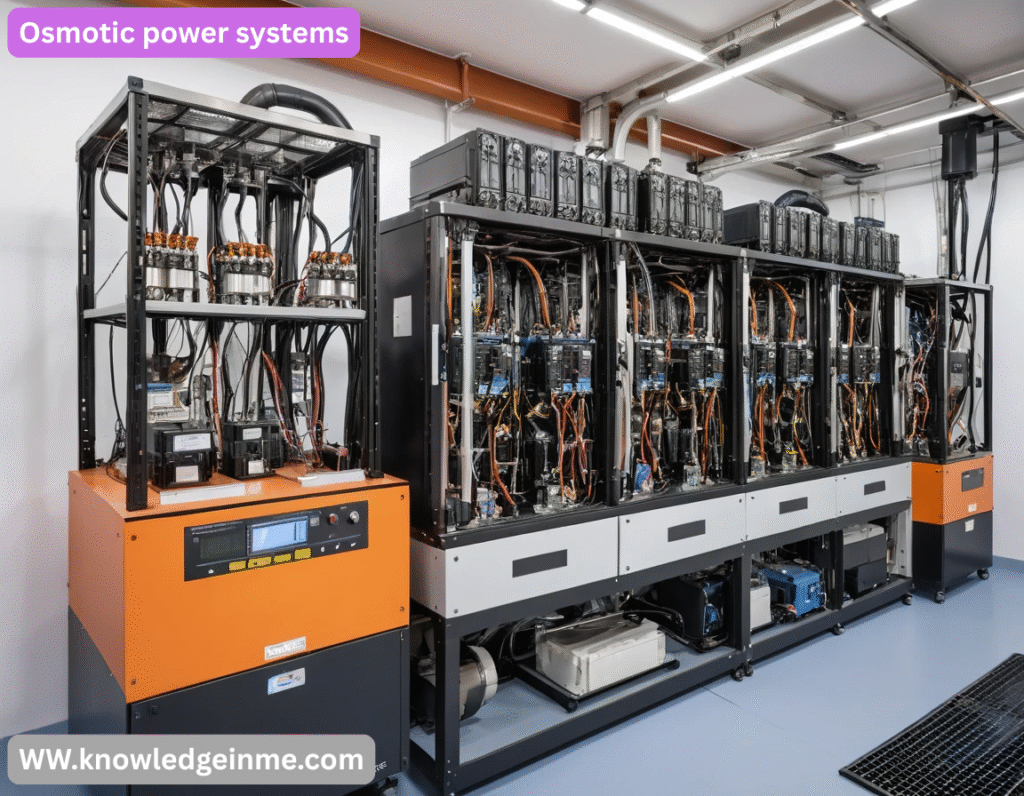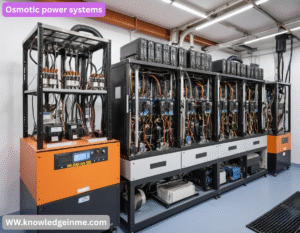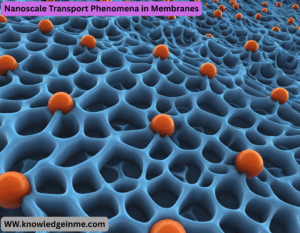Osmotic power systems Osmotic power, also known as salinity gradient power (SGP), is a renewable energy technology that generates electricity by exploiting the energy difference between saltwater (e.g., seawater) and freshwater (e.g., river water). This process relies on osmosis—a natural phenomenon where water moves through a semi-permeable membrane from a low-salt concentration to a high-salt concentration.
How Osmotic Power Works
- Two primary methods are used to extract energy from salinity gradients:
Pressure-Retarded Osmosis PRO
- Process: Freshwater flows through a semi-permeable membrane into pressurized saltwater, increasing the pressure on the saline side.
- Energy Extraction: The pressurized saltwater drives a turbine to generate electricity.
- Efficiency: Typically around 5–10 W/m² of membrane (research aims to improve this).
Reverse Electrodialysis RED
- Process: Uses ion-exchange membranes to separate salt ions (Na⁺ and Cl⁻) between saltwater and freshwater, creating an electric potential.
- Energy Extraction: Electrodes capture the ionic current, converting it into electricity.
- Efficiency: Can reach 1–4 W/m² of membrane, but scalable with stacked membranes.
Advantages of Osmotic Power
- Predictable & Continuous – Unlike solar/wind, it provides stable baseload power.
- Low Environmental Impact – Minimal emissions, no fuel consumption.
- Synergy with Desalination – Can be combined with desalination plants for improved efficiency.
Challenges & Limitations
- High Membrane Costs – Specialized membranes are expensive and prone to fouling.
- Low Energy Density – Requires large membrane areas for significant power output.
- Limited Suitable Locations – Needs access to both freshwater and seawater (e.g., estuaries).
- Competition with Other Renewables – Solar and wind are currently cheaper.
Current Status & Future Prospects
Pilot Plants:
- Statkraft’s PRO Prototype (Norway, 2009–2013) – First large-scale osmotic plant (4 kW), discontinued due to cost issues.
- RED Research (Netherlands, Japan, USA) – Universities and startups are optimizing ion-exchange membranes.
Future Potential:
- If membrane costs decrease, osmotic power could supplement other renewables in coastal regions.
- Hybrid systems (e.g., osmotic + desalination) may improve economic viability.
Core Technologies: PRO vs. RED
Pressure-Retarded Osmosis PRO
Working Principle:
- Freshwater naturally moves through a semi-permeable membrane into pressurized saltwater.
- The increased volume of saltwater raises pressure, driving a turbine.
- Key Equation: Power = Δπ × Q (where Δπ = osmotic pressure difference, Q = flow rate).
Osmotic Pressure
- Seawater (~3.5% salinity) vs. freshwater: ~27 bar (270 m water column equivalent).
- Real-world systems achieve ~10–15 bar due to inefficiencies.
Challenges:
- Membrane Fouling: Organic matter, bacteria, and particles clog membranes.
- Salt Leakage (“Reverse Salt Diffusion”) reduces efficiency.
Reverse Electrodialysis RED
Working Principle:
- Alternating cation-exchange membranes (CEMs) and anion-exchange membranes (AEMs) separate Na⁺ and Cl⁻ ions.
- Ion flow generates a voltage (0.1–0.2 V per membrane pair).
- Stacking multiple membranes increases power output.
Key Factors:
- Membrane Selectivity: High ion conductance but low water permeability.
- Stack Resistance: Internal resistance reduces efficiency.
Challenges:
- Fouling & Scaling: Ca²⁺, Mg²⁺, and organics degrade membranes.
- Cost: Specialty ion-exchange membranes are expensive (~$50–100/m²).
Membrane Technology: The Heart of Osmotic Power
PRO Membranes
- Requirements:
- High water permeability (A-value > 1 L/m²·h·bar).
- Low salt permeability (B-value < 0.1 L/m²·h).
- Mechanical strength to withstand high pressures.
Materials:
- Thin-Film Composite (TFC) membranes (polyamide active layer on polysulfone support).
- Biomimetic membranes (aquaporin-based for ultra-high selectivity).
RED Membranes
- Requirements:
- High ion selectivity (>90% for Na⁺/Cl⁻).
- Low electrical resistance (<5 Ω·cm²).
Materials:
- Homogeneous ion-exchange membranes (e.g., Neosepta, Fumasep).
- Nanocomposite membranes (graphene oxide, MOFs for improved performance).
Fouling Mitigation Strategies
- Pre-treatment: Microfiltration, UV sterilization.
- Anti-fouling Coatings: Hydrophilic polymers (PEG, zwitterions).
- Pulsing & Backwashing: Periodic flow reversal.
Key Cost Drivers:
- Membranes (50–60% of system cost).
- Pre-treatment & Maintenance (fouling control).
- Infrastructure (pipelines, turbines for PRO).
Hybrid Systems Improve Economics:
- Osmotic + Desalination: Use brine from desalination to boost salinity gradient.
- Osmotic + Wastewater Treatment: Utilize treated wastewater as freshwater source.
Environmental Impact
Pros:
- Zero CO₂ emissions during operation.
- Minimal ecosystem disruption compared to dams.
- Synergy with water treatment (reduces brine disposal issues).
Cons:
- Brine Discharge (for RED): If using concentrated brine, may harm marine life.
- Membrane Pollution: Degraded membranes could release microplastics.
- Land Use: Requires coastal/riverine infrastructure.
Future Research & Innovations
Next-Gen Membranes
- Biomimetic designs (aquaporin proteins for ultra-permeable membranes).
- Graphene oxide membranes (high selectivity, fouling resistance).
Hybrid Systems
- Osmotic + Solar: Solar-powered pre-treatment to reduce fouling.
- Osmotic + Blue Energy: Combining PRO/RED with tidal or wave energy.
Advanced Fouling Control
- Self-cleaning membranes (photocatalytic coatings).
- AI-driven monitoring for predictive maintenance.
Nanoscale Transport Phenomena in Membranes
Molecular Dynamics (MD) Simulations of Water-Ion Selectivity
- Mechanism: Atomistic modeling reveals why 2D materials (e.g., graphene nanopores, MoS₂) outperform polymers:
- Dielectric exclusion: Ions are repelled by low-dielectric carbon surfaces.
- Quantum confinement effects: Sub-nm pores allow single-file water chains (10x faster flux than Hagen-Poiseuille flow).
- Breakthrough: Angstrom-scale pores (3.5–4.5 Å) enable perfect salt rejection + water permeability >1,000 L/m²·h·bar (Nature 2023).
Electrokinetic Effects in RED
- Overlimiting Current (OLC) Phenomenon:
- Beyond classical diffusion limits, microvortices form near membranes, boosting power density to >60 W/m² (Science Advances 2022).
- Achieved via laser-patterned membranes inducing chaotic advection.
Thermodynamic Limits & Exergy Efficiency
Maximum Extractable Work (Gibbs Free Energy of Mixing)
- For seawater (0.6 M NACI) vs. river water (0.01 M):
- ΔG_mix = ~0.8 kWh/m³ (theoretical max).
- Real systems achieve 0.1–0.3 kWh/m³ (25–40% exergy efficiency).
Entropy Generation Analysis
- Concentration polarization (40% loss).
- Ohmic resistance in RED (30% loss).
- Pressure drops in PRO (20% loss).
Mitigation Strategies:
- Segmented membranes with graded porosity to minimize polarization.
- Super capacitive electrodes in RED to capture transient overpotentials.
Disruptive System Architectures
Forward Osmosis – Pressure-Retarded Osmosis (FO-PRO) Hybrid
How it Works:
- FO draws freshwater through membrane using draw solution (e.g., NH₃/CO₂).
- PRO then pressurizes diluted draw solution.
- Advantage: Decouples membrane from fouling sources (wastewater → FO, seawater → PRO).
- Performance: 18 W/m² demonstrated (Desalination 2023).
Capacitive Reverse Electrodialysis (CRED)
- Innovation: Replaces RED’s electrodes with capacitive carbon electrodes:
- Stores ions during charging, releases during discharge (pulsing).
- 5x higher power density (20 W/m²) by avoiding redox reactions.
Osmotic Heat Engines
- Concept: Use temperature gradients to enhance salinity-driven flow:
- Thermo-osmotic membranes (e.g., carbon nanotubes) generate additional 2–3 bar/K.
- Combined solar-thermal input boosts output by 50%.
Pilot Projects & Unconventional Applications
Mega-Scale PRO in the Amazon Delta (Theoretical Study)
- Design: 100 km² membrane arrays at river-ocean interface.
- Output: 1.2 GW (equivalent to a nuclear reactor).
- Hurdles: Sediment clogging, biodiversity impacts.
Micro-Osmotic Generators for IoT
- MIT’s “Salty Battery”: RED stack powering sensors using <1 mL/min flows.
- Power Output: 100 µW/cm² – enough for LORA WAN nodes.
Hypersaline Brine Mining
- Synergy with Lithium Extraction: RED selectively concentrates Li⁺ from brine while generating power.
- Economics: Adds $0.05/kWh revenue stream to lithium production.
AI & Automation in Osmotic Plants
Machine Learning for Fouling Prediction
- Neural Networks analyze feedwater chemistry + historical data to:
- Optimize cleaning cycles (saving 15% OPEX).
- Predict membrane lifespan within ±5%.
Robotics for Membrane Replacement
- Autonomous drones in large-scale PRO farms swap modules without dry docking.






